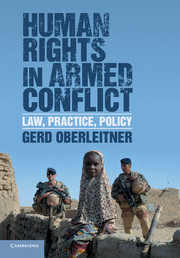Book contents
- Frontmatter
- Contents
- Acknowledgments
- Table of cases
- Table of Legal Instruments
- List of Abbreviations
- Introduction
- Part I Human rights in armed conflict: history of an idea
- Part II Human rights and humanitarian law: theory
- Part III Human rights and humanitarian law: challenges and commonalities
- 8 The right to life: the limits of human rights in armed conflict?
- 9 The extra-territorial application of human rights: functional universality
- 10 War as emergency: derogation
- 11 Human rights and humanitarian obligations
- 12 Operationalizing human rights in armed conflict
- Part IV The dynamics of war and law
- Part V Enforcement: practice and potential
- Conclusion
- Bibliography
- Index
- References
8 - The right to life: the limits of human rights in armed conflict?
Published online by Cambridge University Press: 05 March 2015
- Frontmatter
- Contents
- Acknowledgments
- Table of cases
- Table of Legal Instruments
- List of Abbreviations
- Introduction
- Part I Human rights in armed conflict: history of an idea
- Part II Human rights and humanitarian law: theory
- Part III Human rights and humanitarian law: challenges and commonalities
- 8 The right to life: the limits of human rights in armed conflict?
- 9 The extra-territorial application of human rights: functional universality
- 10 War as emergency: derogation
- 11 Human rights and humanitarian obligations
- 12 Operationalizing human rights in armed conflict
- Part IV The dynamics of war and law
- Part V Enforcement: practice and potential
- Conclusion
- Bibliography
- Index
- References
Summary
Paradigmatic differences: war-fighting and law enforcement
Like many others, the International Committee of the Red Cross (ICRC) sees “the greatest differences” between international humanitarian law and international human rights law in the right to life. In the eyes of many commentators, the way in which human rights and humanitarian law think about the use of deadly force – the central element of armed conflicts – reflects paradigmatic differences so profound that there can be no complementarity in this matter. Humanitarian law can be seen as a permissive regime which grants positive authorization to use force in order to achieve military aims. In a seemingly paradox way, it facilitates and, at the same time, limits killing and destruction, whereas international human rights law is restrictive and accepts lethal force only as last resort. For humanitarian law, the use of force is an integral part of the law, while killing is antithetical to the very idea of human rights. In light of these considerations it has been suggested that the two regimes need to be kept “distinct as far as possible” – but how far is as far as possible? Are the differences between human rights and humanitarian law on this question so fundamental that (at least) this very core of humanitarian law must be preserved uninfluenced by human rights law even if their application might be accepted in other areas of armed conflict? Or is the difference merely a gradual one, and a complementary application of human rights and humanitarian law is possible? There is profound disagreement on this question, compounded by the fact that, somewhat surprisingly and despite the importance of this matter, the links between the human right to life and humanitarian law have only rather recently been subjected to a more thorough analysis beyond blanket statements of their incompatibility.
- Type
- Chapter
- Information
- Human Rights in Armed ConflictLaw, Practice, Policy, pp. 131 - 143Publisher: Cambridge University PressPrint publication year: 2015



